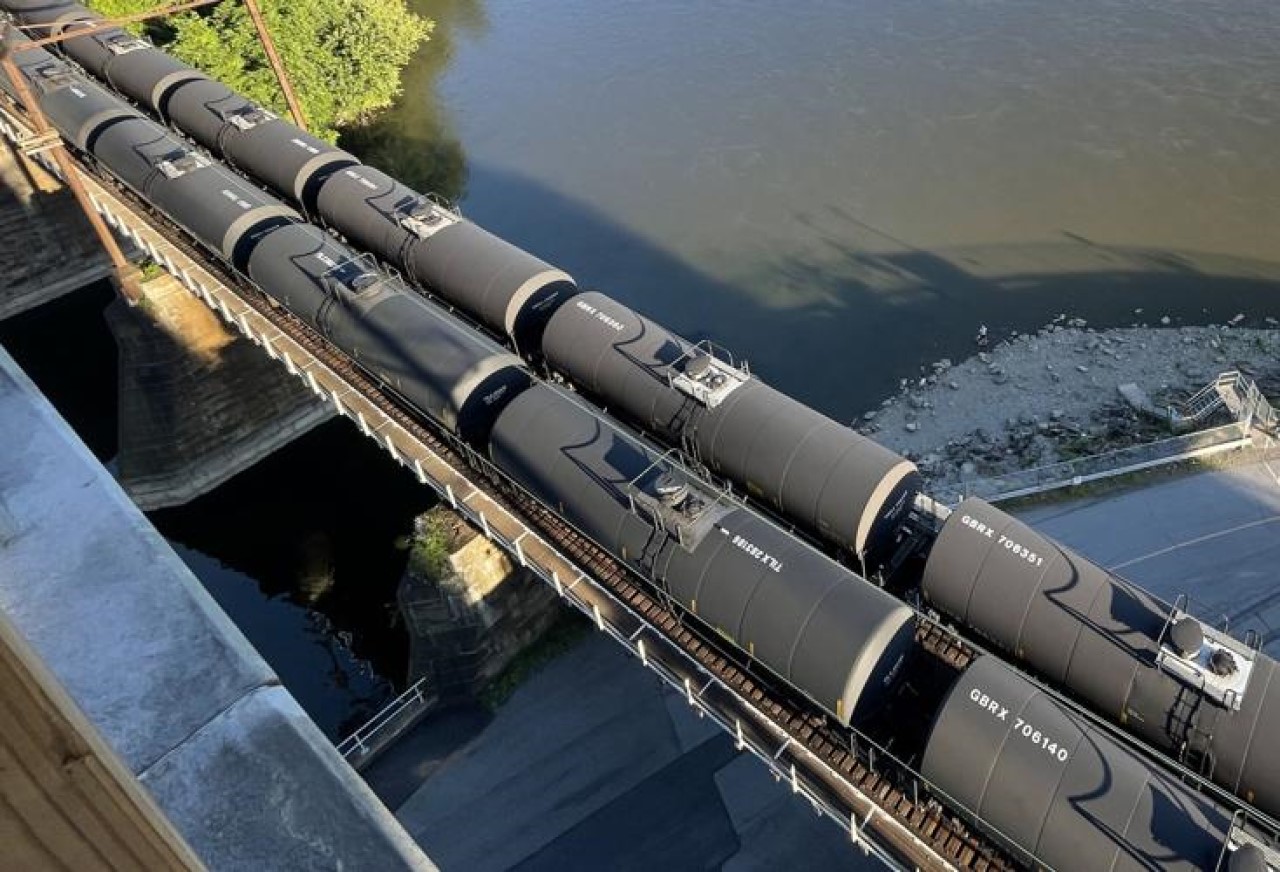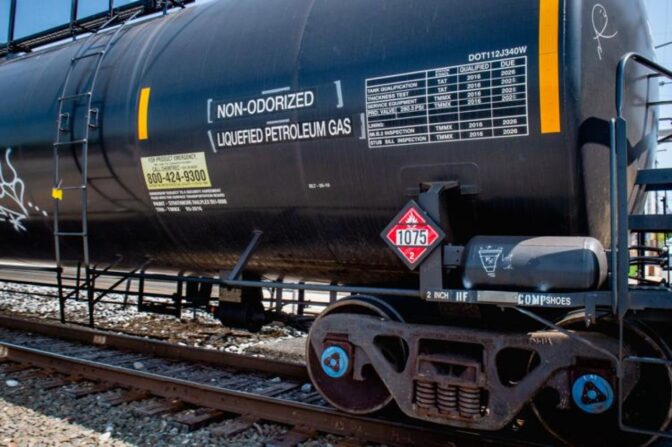
A pair of trains with tank cars sit on Norfolk Southern railroad line along the Susquehanna River at Safe Harbor June 5, 2022.
Blaine Shahan / LNP | LancasterOnline

A pair of trains with tank cars sit on Norfolk Southern railroad line along the Susquehanna River at Safe Harbor June 5, 2022.
Blaine Shahan / LNP | LancasterOnline

Blaine Shahan / LNP | LancasterOnline
A pair of trains with tank cars sit on Norfolk Southern railroad line along the Susquehanna River at Safe Harbor June 5, 2022.
This story is published in partnership with our sister newsroom LNP | LancasterOnline.
The windows rattled on Frank Frederick’s Union Street home in Columbia when the train passed 40 feet from his side yard.
Frederick and his neighbors have been worried about what’s on those trains since the Feb. 3 Norfolk Southern train derailment in East Palestine, Ohio, near the Pennsylvania line, which prompted the intentional release and burning of toxic vinyl chloride and the evacuation of more than a thousand residents.
“I have been wondering what it is on the trains, but nobody wants to say anything, and we can’t really do anything,” Frederick, 42, yelled over the train. “I try not to really think about it.”
We sought railroad hazmat records from 12 central Pa. counties; only 3 provided detailed lists
Hazardous material on Pa. trains: How we got the information
Who responds? When do you evacuate? A look at Lancaster County’s Hazardous Rail Transit Plan
At least 28 hazardous materials moved through Lancaster County in 2021
The people along the tracks in Columbia aren’t alone in not knowing.
The trains that run near Frederick’s house and along about 135 active miles of rail in Lancaster County can at any point be carrying hazardous material. But getting real-time information on those materials is nearly impossible because in a post-9/11 environment, railroads aren’t required to share that information.
Reporters for LNP | LancasterOnline and WITF sought detailed information about train cargo from 12 central Pennsylvania counties. Only three of those counties said they had lists of specific chemicals being carried by trains. None had real-time information.
That secrecy means emergency responders might not know what hazardous materials they’re dealing with until they reach the scene, and that there is no single, consistent way to find the information at the scene — all of which could slow response time or put them in danger.
State and federal legislators are calling for greater transparency, as ongoing Congressional testimony has shown first responders weren’t able to access information about the chemicals in the overturned cars in Ohio right away.
The railroad has been under criticism for its response time.
“There’s not enough information upfront, and it is frustrating,” said Duane Hagelgans, emergency management coordinator for Millersville and Manor Township. Hagelgans also is the fire commissioner for Blue Rock Fire Rescue and a professor of emergency management at Millersville University.
“It would certainly be much more beneficial if we had it quicker.”

Blaine Shahan / LNP | LancasterOnline
A Norfolk Southern train crosses Front Street In Columbia Borough Monday, April 17, 2023.
About 115,000 households in Lancaster County are within 1.3 miles of rail lines — or the recommended evacuation distance for a situation similar to the Ohio derailment, according to county commissioners and Lancaster Emergency Management Agency.
“I see the lumber cars go by, but I also see the tankers and wonder what it is in them,” Jarred Ebert, 39, said.
Ebert’s home on Second Street in Columbia is a block from the tracks.
Norfolk Southern, the railroad at the center of the East Palestine disaster, has rail lines in 25 Lancaster County municipalities including Columbia and didn’t respond to requests for information.
Federal Rail Administration representatives said government officials can request information from railroads annually, but they aren’t legally required to provide the information.
County officials, when asked about hazardous materials, said that information is compiled for emergency preparedness and isn’t shared publicly.
Through a Right-to-Know request, the county provided a 2021 commodity report — the most recent available — for hazardous materials on county rail lines.
That document listed vinyl chloride, along with 27 other hazardous materials. The list included chlorine, commonly used in water treatment; liquid petroleum gas, commonly used in cooking and heating; methanol, commonly used as an additive to gasoline; and propane, commonly used with barbecue grills.
“These are things that are not dangerous in low amounts but can be harmful at high amounts,” said Jeremiah Mbindyo, an environmental professor in the chemistry department at Millersville University.
Mbindyo noted the majority of the chemicals on the county’s 2021 list are common-use chemicals for many industries.
“Like they say, ‘The dose makes the poison,’” Mbindyo said.
“The scarier thing is the environment aspect,” said 77-year-old Mary Wickenheiser, of Columbia, who frequently walks the Columbia River Trail along the Susquehanna River. “The trains run right along the shore line.”
Certain chemicals carry immediate explosion or inhalation risks, Mbindyo said, noting some long-term risks include water supply contamination.
Some raw materials for synthetic polymers interfere with the body’s hormones. Others can cause cancer in living tissue.
Petroleum crude oil, which is not water soluble, was on the 2021 commodity list. If it gets into water, wildlife will get it on their bodies, Mbindyo said.
The 2021 list was created by county personnel, who went to rail lines, observed trains and recorded the hazardous material codes from placards on the side of the cars, said Michael Fitzpatrick, a county government spokesperson, and Zack Gibbons, the hazardous materials administrator for Lancaster Emergency Management Agency.
County officials aim to compile a hazardous commodities transportation list every other year as a practice; however, the state requires it only every five years, Fitzpatrick said.
A Right-to-Know request for past commodity reports for railroad hazardous materials was denied. County officials said those records do not exist.
“I watch the placards on the trains and think, ‘Just keep going,’ ” Wickenheiser said.
HAS IT HAPPENED IN LANCASTER COUNTY?
There have been three accidents involving trains and hazardous materials in Lancaster County since 2000 that the Lancaster County Commissioners and Lancaster Emergency Management Agency called serious.
A 115- car Norfolk Southern Railroad freight train with 31 tanker cars, each filled with about 20,000 gallons of highly corrosive acid, leaked some of the liquid onFriday, Oct. 13, 2000. More than 125 people were evacuated for about 12 hours. DEP ultimately determined the spill was accidental, and Norfolk Southern was not fined.
A train carrying pentane leaked some of the liquid along the Norfolk Southern tracks at Dillerville Road in Lancaster cityon Monday, Nov. 14, 2005. The leak prompted officials to close Dillerville Road from Harrisburg Pike to Manheim Pike for about three hours. The leak didn’t result in injuries or property damage.
A train carrying butane at Lancaster Propane Gas off Route 230 near Mount Joy caught fire on Tuesday, July 2, 2013. John Wolgemuth, the propane firm’s terminal manager, sustained serious injuries from butane freeze burns to his chest. The fire resulted in evacuations of nearby businesses and a hospice center.
“The trains that go through Lancaster County are a definite concern,” said Randall Gockley, president of the Lancaster County Firemen’s Association. The association represents more than 80 organizations and more than 750 members in the county.
As much as 40% of the freight transported by trains each year in Pennsylvania is considered hazardous, Carl Belke, president of the Keystone State Railroad Association, said during a state Senate Transportation Committee hearing this year.
“Anytime you’re facing the unknown, it’s scarier than when you know what you’re going into,” said Jay Barninger, emergency management coordinator for Columbia. “If you know what the chemical is ahead of time, it would be different.”

Blaine Shahan / LNP | LancasterOnline
A railroad car labeled and placarded to be carrying liquified petroleum gas, moves on the railroad line along Front Street in Columbia Borough Wednesday, May 10, 2023.
Trains carry a manifest, or train inventory, that can be shared by the engineer during a rail disaster. That list should be kept within arm’s reach of the engineer, Gockley said.
“If the engineer is injured or something like that, then you have to depend on getting the information from other sources like Norfolk Southern, which could be a time delay,” Gockley said.
In the event of a disaster, emergency responders can access hazardous material manifests through the AskRail app, which was developed in 2014 by Class 1 railroads like Norfolk Southern and Amtrak to provide real-time data. It is available only to verified emergency responders, who have to submit their positions as well as supervisor information to get access.
The app, though, is not mandated, and since the East Palestine disaster, questions have been raised about the effectiveness of the communication system.
“Apps are OK, but they’re not the end-all be-all,” Hagelgans said. In a hazardous materials situation, he said, responders never look at just one source.
The county’s Hazardous Rail Transit Plan encourages first responders to use obvious signs at the scene (like vapor clouds, hissing, spills), to talk to eyewitnesses, check placards on rail cars and check information on rail-grade crossings.
Emergency vehicles carry books that contain information on tanker codes as well as standard tanker shapes, Gordonville Fire Captain Dave Johnson said.
All fire vehicles should have binoculars in them to help identify the placards from a distance because firefighters should get an idea of the situation before entering the scene, Gockley said.
While this is happening, 911 dispatch can call the train company or help locate the engineer, he said.
Both Hagelgans and Gockley said that the size of trains makes response to them difficult.
“The thing is, when a train is going through the community, you can have a variety of different chemicals on different cars,” Gockley said. “The engine could be parked in one municipality and the actual fire in another municipality because of the length of the train with a lot of cars involved.”
About 300 firefighters from 50 departments responded to the February derailment in East Palestine. Gockley said if the same thing happened in Lancaster County, the response would be the same, and many of those responders would be volunteer firefighters.
“When you have an event like a train derailment, and if you throw hazardous materials on top … it is such a low-frequency event for the average fire department that it can be quickly catastrophic,” Hagelgans said. “It’s very difficult to make the right decisions because you don’t have that skill set from practice.”
AN EXCEPTION TO SECRECY
If a train is classified as a High Hazard Flammable Train, the Pennsylvania Emergency Management Agency (PEMA) is notified of the specific freight it is hauling around or through an area, said John Repetz, community relations coordinator with the Department of Environmental Protection. A High Hazard Flammable Train is a single train transporting 20 or more loaded tank cars of a “Class 3 flammable liquid” or flammable liquid with a designated fixed lowest temperature at which vapors can ignite when exposed to flame.
The East Palestine derailment spurred federal and state legislative efforts regarding railroad safety, increased transparency and advance notice for emergency responders on trains carrying hazardous materials.
Officials investigating the Ohio derailment testified in front of the U.S. Senate’s Commerce, Science and Transportation Committee in March that first responders in Ohio weren’t able to access information about the chemicals in 11 overturned cars carrying hazardous materials.
And during a public hearing late last month, National Transportation Safety Board Chairwoman Jennifer Homendy questioned why it took Norfolk Southern an hour to several hours before providing information to emergency responders.
On the federal level, the Railway Safety Act of 2023 and the Assistance for Local Heroes During Train Crises Act was introduced.
The Assistance for Local Heroes During Train Crises Act includes a proposal that would direct the federal secretary of transportation and the administrator of the transportation security administration to develop regulations requiring railroads to notify local emergency response groups, fire departments and law enforcement agencies when hazardous materials are moving through their communities.
The U.S. Department of Transportation’s Pipelines and Hazardous Materials Safety Administration proposed a rule June 21 that would require all railroads to immediately send the details of everything on their trains to every emergency responder within 10 miles during an emergency.
The proposed rule would apply to every railroad that carries chemicals and would send electronic push alerts anytime there is a derailment or hazardous chemical release.
At the state level, House Bill 1028 proposes several measures including creating a database that would be accessible to emergency management agencies of hazardous material being transported through the state on railways. Three Lancaster County Republicans — state Reps. David Zimmerman, Keith Greiner and Tom Jones — were among 62 votes against the bipartisan bill.
“Since the measures in the bill will be trumped by federal law anyhow, the bill feels more like a, ‘Look, we did something about the Palestine train derailment’ political measure rather than actually offering solutions,” said Jones, whose 98th District stretches from Marietta into Lebanon County.
In Lancaster County, Hagelgans, Gockley, Barninger and Johnson all said they would be in favor of any proposed legislation that would get real-time information to first responders.
“It would definitely save time and be helpful for the incident commander to know earlier,” Gockley said.
He is wary of sharing information publicly because of the risk of terror attacks, he said, but as long as the information is secure, he would support anything that would help the firefighters.
Overall, Barninger said he’s confident they are doing everything they can to prepare for any hazardous materials on trains. However, Barninger said he believes more information would be beneficial to the responders and the community the materials pass through.
“It would be amazing if there was some way that we can get real time information as the trains are passing through our community,” Barninger said. “It would definitely save us time.”
Hagelgans expressed concern with accuracy on any proposed database and about who would maintain it but that having a start from a database “would be beneficial.”
“The more information you have, the better solutions you can create, quicker,” Hagelgans said.

Sometimes, your mornings are just too busy to catch the news beyond a headline or two. Don’t worry. The Morning Agenda has got your back. Each weekday morning, host Tim Lambert will keep you informed, amused, enlightened and up-to-date on what’s happening in central Pennsylvania and the rest of this great commonwealth.
The days of journalism’s one-way street of simply producing stories for the public have long been over. Now, it’s time to find better ways to interact with you and ensure we meet your high standards of what a credible media organization should be.